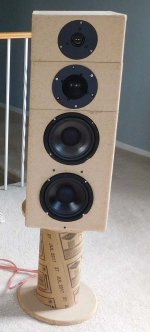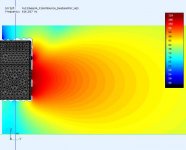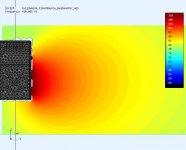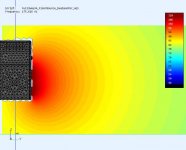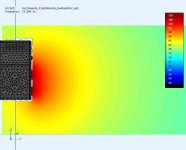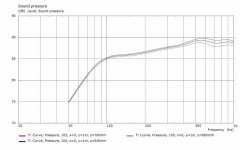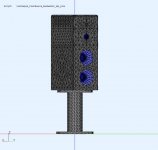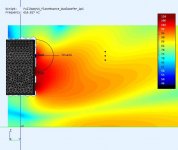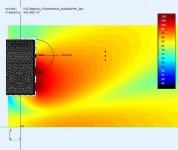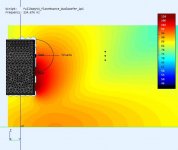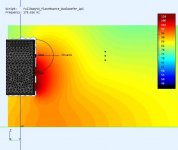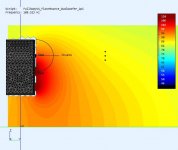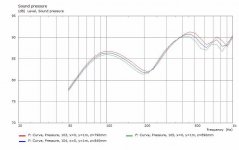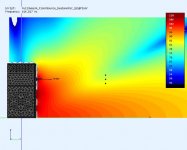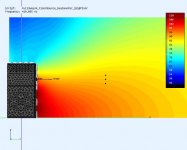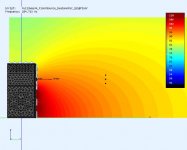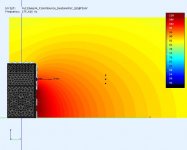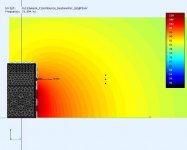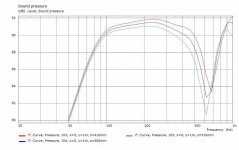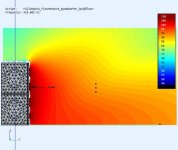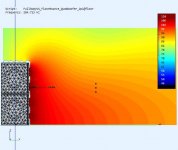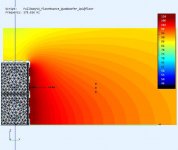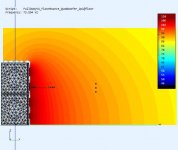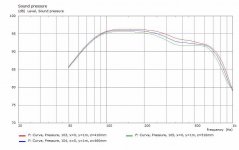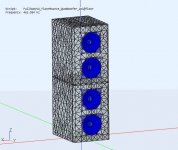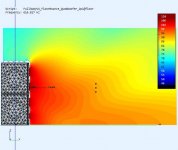I liked this question, and thought about it, and then ran some simulations that I'll share. Hopefully interest has not faded. I'm still not sure floor bounce is a problem because all my speakers do it and I've probably adapted to it. The floor is the one surface I can't get my speakers away from  There are a lot of good suggestions here that I'll adapt to a BEM sim to see what they look like.
There are a lot of good suggestions here that I'll adapt to a BEM sim to see what they look like.
The pics below are from a model of an actual speaker simulated in 4Pi space. You can see the SPL baffle lost at low freq because no BSC has been applied. In the last pic @616Hz you can see my midrange starting to emit. The woofers are 6.5", the midrange is 2" and the tweeter is 1.125". The field pics have the speaker stand removed.
The pics below are from a model of an actual speaker simulated in 4Pi space. You can see the SPL baffle lost at low freq because no BSC has been applied. In the last pic @616Hz you can see my midrange starting to emit. The woofers are 6.5", the midrange is 2" and the tweeter is 1.125". The field pics have the speaker stand removed.
Attachments
Now, lets take that model a put a floor under it where the speaker stand would sit. This is 2Pi space.
There is no problem at lower freq, so something like my subwoofer's height won't see the floor bounce effect (it will see room modes). As the freq increases there is a null forming due to the floor reflection. The null then arcs over depending on the frequency, speaker size and height off the floor. Knowing this you could pick a measurement spot or listening spot to avoid it. In this case I used 3 points (small black dots in field pic), 5cm spacing, centered on the midrange at a distance of 1m from the speaker. The null is still there even if you pick a good spot to measure If you moved back far enough from the speaker you won't notice it and the room reflections (from the other 5 surfaces) may fill it if you gate your measurement long enough.
If you moved back far enough from the speaker you won't notice it and the room reflections (from the other 5 surfaces) may fill it if you gate your measurement long enough.
There is no problem at lower freq, so something like my subwoofer's height won't see the floor bounce effect (it will see room modes). As the freq increases there is a null forming due to the floor reflection. The null then arcs over depending on the frequency, speaker size and height off the floor. Knowing this you could pick a measurement spot or listening spot to avoid it. In this case I used 3 points (small black dots in field pic), 5cm spacing, centered on the midrange at a distance of 1m from the speaker. The null is still there even if you pick a good spot to measure
Attachments
A few suggestions were to put the woofer near the floor. That seems to make sense, but makes it difficult to center the mid/tweet at ear level. This sim is 2Pi space, same speaker sitting on the floor now.
No floor bounce for the LF but now my midrange is close to the floor and I get a floor bounce from it. The null has been moved to a higher freq. An argument could be made that this is better because it's easier to reduce a higher freq reflection using a rug or some floor treatment.
No floor bounce for the LF but now my midrange is close to the floor and I get a floor bounce from it. The null has been moved to a higher freq. An argument could be made that this is better because it's easier to reduce a higher freq reflection using a rug or some floor treatment.
Attachments
Another suggestion was multiple drivers like arrays. That does make sense as the drivers start at the floor. As a compromise, because I still want a 3-way speaker, I'll stack woofers until the mid/tweeter sections (if present) would be at my ear. In this case that's 4 woofers. I've removed the mid+tweet sections in this model.
The floor bounce null seems to be removed. This seems like a reasonable solution and I can still put the mid+tweeter sections back at ear level.
The floor bounce null seems to be removed. This seems like a reasonable solution and I can still put the mid+tweeter sections back at ear level.
Attachments
A for effort so far. You have modeled one surface (the floor). Now model all the other surfaces in the room and include multiple reflections to 3rd order. This would be a much more realistic model of the listening space. If you can do that I think that you will see that room modes and resonances are more important, and multiple reflections fill in the null that you see when only considering the floor.
Agreed, see post #62, #63.
It's just the floor bounce is the first reflection. So I wanted to see what it would look like and if it could be avoided.
OK, no problem. As you probably have observed, when you use multiple drivers in a short line such as WWWMT or in a WWMTWW type arrangement you can mostly eliminate the null even when you consider only the floor reflection. Something like a CBT will go even further in that regard.
- Status
- This old topic is closed. If you want to reopen this topic, contact a moderator using the "Report Post" button.
- Home
- Loudspeakers
- Multi-Way
- Why is floor bounce considered only a bass issue?
